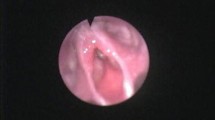Abstract
The aim is to determine clinical characteristics, flexible bronchoscopy (FB) findings including associated airway abnormalities and other conditions, treatment modalities and long term follow-up of children with congenital stridor. Medical records of children, who underwent FB for the evaluation of stridor between 1 January 2004 and 31 December 2009 were retrospectively reviewed. Demographic characteristics, symptoms and physical examination findings at presentation, FB findings, follow-up data including the time to resolution of symptoms and treatment modalities, presence of associated conditions were assessed. 109 children were enrolled to the study. Laryngomalacia was the most common etiology for stridor. Laryngomalacia was isolated in 37 patients and 54 patients had secondary airway lesions (SALs). Diagnoses other than laryngomalacia such as subglottic hemangioma, subglottic web, isolated tracheomalacia were found in 18 patients. In 90 % of patients, stridor resolved before 3 years of age without any surgical intervention and there was no significant difference in terms of the persistence of stridor between patients with isolated laryngomalacia and associated SALs. Duration of stridor was significantly longer in both patients with neurological abnormalities and reflux symptoms. Surgical procedure was performed in 19 of the patients. There is a high incidence of SALs in patients with laryngomalacia. FB is helpful for identifying anomalies requiring surgical treatment.
Similar content being viewed by others
References
Holinger LD (1997) Congenital laryngeal anomalies. In: Holinger LD, Lusk RP, Gren CG (eds) Pediatric Laryngology & Bronchoesophagology. Lippincott–Raven, Philadelphia, pp 137–164
Holzki J, Laschat M, Stratmann C (1998) Stridor in the neonate and infant. Implications for the paediatric anaesthetist. Prospective description of 155 patients with congenital and acquired stridor in early infancy. Paediatr Anaesth 8:221–227
Nussbaum E, Maggi JC (1990) Laryngomalacia in children. Chest 98:942–944
Balfour Lynn IM, Spencer H (2002) Bronchoscopy—how and when? Paediatr Pespir Rev 3:255–264
Midulla F, de Blic J, Barbato A, Bush A et al (2003) Flexible endoscopy of paediatric airways. Eur Respir J 22:698–708
Kuo CH, Niu CK, Yu HR et al (2008) Applications for flexible bronchoscopy in infants with congenital vocal cord paralysis: a 12 year experience. Pediatr Neonatol 49:183–188
O’Sullivan BP, Finger L, Zwerdling RG (2004) Use of nasopharyngoscopy in the evaluation of children with noisy breathing. Chest 125:1265–1269
Vijayasekaran D, Gowrishankar NC, Kaplana S et al (2010) Lower airway anomalies in infants with laryngomalacia. Indian J Pediatr 77:403–406
Masters IB, Chang AB, Patterson L et al (2002) Series of laryngomalacia, tracheomalacia, and bronchomalacia disorders and theris associations with other condirtions in children. Pediatr Pulmonol 34:189–195
Sánchez I, Pesce C, Navarro H et al (2003) Clinical characterstics of children with tracheobronchial anomalies. Pediatr Pulmonol 35:288–291
Boogaard R, Huijsmans SH, Pijnenburg MWH et al (2005) Tracheomalacia and bronchomalacia in children: incidence and patient characteristics. Chest 128:3391–3397
Parente Hernández A, García-Casillas MA, Matute JA et al (2007) Is stridor a banal symptom in infants? An Pediatr (Barc) 66:559–565
Krashin E, Ben-Ari J, Springer C et al (2008) Synchronous airway lesions in laryngomalacia. Int J Pediatr Otorhinolaryngol 72:501–507
Yuen HW, Tan HK, Balakrishnan A (2006) Synchronous airway lesions and asssociated anomalies in children with laryngomalacia evaluated with rigid endoscopy. Int J Pediatr Otorhinolaryngol 70:1779–1784
Bluestone CD, Healy GB, Cotton RT (1996) Diagnosis of laryngomalacia is not enough. Arch Otolaryngol Head Neck Surg 122:1417–1418
Mancuso RF (1996) Laryngomalacia: the search for the second lesion. Arch Otolaryngol Head Neck Surg 122:302–306
Nielson DW, Ku PL, Egger M (2000) Topical lidocaine exaggerates laryngomalacia during flexible bronchoscopy. Am J Respir Crit Care Med 161:147–151
Hartzell LD, Richter GT, Glade RS et al (2010) Accuracy and safety of tracheoscopy for infants in a tertiary care clinic. Arch Otolaryngol Head Neck Surg 136:66–69
Dickson JM, Richter GT, Meinzen-Derr J et al (2009) Secondary airway lesions in infants with laryngomalacia. Ann Otol Rhinol Laryngol 11:37–43
Schroeder JW Jr, Bhandarkar ND, Holinger LD (2009) Synchronous airway lesions and outcomes in infants with severe laryngomalacia requiring supraglottoplasty. Arch Otoloaryngol Head Neck Surg 135:647–651
Martins RHG, Dias NH, Castilho EC et al (2006) Endoscopic findings in children with stridor. Rev Bras Otorrinolaringol 72:649–653
Gandhi S, Oswal V, Thekedar P et al (2011) Role of transoral CO2 laser surgery for severe pediatric laryngomalacia. Eur Arch Otorhinolaryngol 268:1479–1483
Belmont JR, Grundfast K (1984) Congenital laryngeal stridor (laryngomalacia): etiological factors and associated disorder. Ann Otol Rhinol Laryngol 93:430–437
Wiggs JRWJ, DiNardo LJ (1995) Acquired laryngomalacia: resolution after neurologic recovery. Otolaryngol Head Neck Surg 112:773–776
Thompson DM (2007) Abnormal sensorimotor integrative function of the larynx in congenital laryngomalacia: a new theory of eitology. Larngoscope 117:1–33
Bibi H, Khvolis E, Sheseyov D et al (2001) The prevelance of gastroesaphageal reflux in children with tracheomalacia and laryngomalacia. Chest 119:409–413
Matthews BL, Little JP, Mcquirt WF Jr et al (1999) Reflux in infants with laryngomalacia: results of 24 hour double-probe pH monitoring. Otoloaryngol Head Neck Surg 120:860–864
Giannoni C, Sulek M, Friedman EM et al (1998) Gastroesophageal reflux association with laryngomalacia: a prospective study. Int J Pediatr Otorhinolaryngol 43:11–20
Acknowledgements
FK, RE and BK designed the research and developed the protocol; FU, EE and YG collected the datas; FK performed the flexible bronchoscopy; EE and YG followed up the patients; BK performed the statistical analysis; EE wrote the manuscript; FK and RE contributed to the writing of the manuscript.
Conflict of interest
None of the authors has a financial or proprietary interest in any method or material mentioned in the text.
Author information
Authors and Affiliations
Corresponding author
Rights and permissions
About this article
Cite this article
Erdem, E., Gokdemir, Y., Unal, F. et al. Flexible bronchoscopy as a valuable tool in the evaluation of infants with stridor. Eur Arch Otorhinolaryngol 270, 21–25 (2013). https://doi.org/10.1007/s00405-012-2057-9
Received:
Accepted:
Published:
Issue Date:
DOI: https://doi.org/10.1007/s00405-012-2057-9




